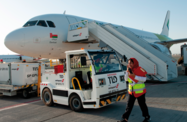As part of a broader strategy to diversify away from the energy sector and capitalise on its position at the centre of various global logistics supply chains, Oman is looking to integrate and expand its road, rail, airport and seaport networks.

On April 22 the national carrier Oman Aviation Group (OAG) announced plans to develop a dedicated air cargo corridor.
Speaking at the launch of the project, Mustafa al Hinai, the CEO of OAG, said the planned corridor would improve the efficiency of export outflows and boost connectivity between the country’s export areas and free zones.
To help facilitate the project, the national carrier is working with the Public Authority of Civil Aviation to sign bilateral open skies agreements with the EU and countries in Asia and Africa, allowing for a reduction in Customs controls and a streamlining of processing procedures.
The proposed air corridor dovetails with a national strategy to improve air freight capacity. Launched in late 2018, the initiative aims to boost transport connectivity and increase the annual volume of cargo moved by air from 223,000 tonnes to 730,000 tonnes by 2030.
Meanwhile, in an effort to boost the logistics capacity of the shipping segment, the Ministry of Transport and Communications (MoTC) announced in February that five new pilot projects are to be launched at the country’s ports.
These projects include the construction of a 160-metre berth for handling goods and equipment at the Port of Suwaiq, and across-the-board plans to reduce the time taken to inspect goods by 10%.
Developing the county’s overall transport and logistics infrastructure as a means to spur innovation and achieve economic diversification is at the centre of Oman’s ninth five-year development plan for the 2016-20 period.
Indeed, as a result of rising investment in these areas, Oman increased its position in the World Bank’s Logistics Performance Index by 16 places between 2014 and last year, and now ranks 43rd out of 160 countries.
See also: The Report – Oman 2019
Safe haven
The development of Oman’s logistics capacity also enables the country to leverage its strategic position and provide an alternative trade route to the congested Strait of Hormuz.
Rising regional tensions following strikes against Saudi oil tankers, coupled with increased hostility between the US and Iran, have seen insurance rates for shipping passing through the strait rise to their highest level since 2005.
With its main ports located outside the Strait of Hormuz, Oman is in a strong position to increase the volume of goods transported through its territory, particularly en route to neighbouring Saudi Arabia and the UAE, with which it has well developed road and rail links.
The connectivity of Oman with its neighbours is set to be further strengthened with the opening of the long awaited 680-km highway through the Empty Quarter desert to Saudi Arabia.
The new road, which is expected to shorten the distance between the two countries by 800 km, is slated to open in the second half of this year.
Learning to grow
The expansion of the country’s transport and logistics sector also offers an opportunity to drive Omanisation, a long-standing policy by which the government seeks to increase the share of Omani nationals in the workforce, particularly in the private sector.
Total employment in the sector rose from 30,000 in 2014 to 84,000 in late 2018, according to data from Asyad Group, the holding company for the state’s investments in transport and logistics. While Omanisation stands at 15% overall, Omani nationals occupy 40% of middle- and upper-management positions.
This share has increased steadily in recent years and the MoTC announced in February that it expected the industry to create 2500 new jobs for Omani nationals in 2019.
In order to support this growth, the government recently launched a campaign to raise awareness among students about careers in the industry.
Higher education institutions are augmenting their offerings of professional training programmes. For example, in 2017 Muscat University launched the first dedicated faculty for transport and logistics in the sultanate, which includes a four-year bachelor’s degree programme in logistics and supply chain management.
“Logistics is a key growth sector in Oman and is in great need of young graduates,” Yusra Mouzughi, vice-chancellor of the university, told OBG. “The growth potential of the industry is huge and there is significant demand for new employees to operate airports and seaports."
Muscat University also recently signed an memorandum of understanding with Asyad to further strengthen the ties between industry and academia in the sector, Mouzughi added.


